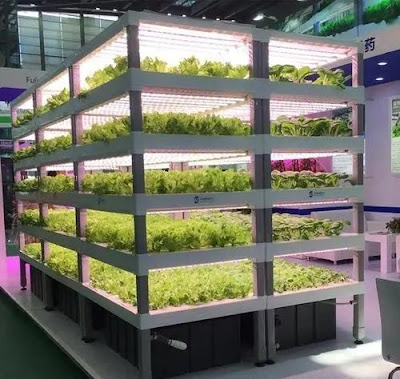In 2018, the grow light market has reached 3 billion 230 million US dollars and is expected to exceed 6 billion 760 million US dollars by 2024. The compound annual growth rate from 2019 to 2024 is expected to be 13.14%. Grow lights are an essential part of urban farming practices. It is often used to provide light to each strip of plant growth, or in some cases to supplement natural light, especially in colder countries with fewer days of sunshine and longer winters.

Full-spectrum LED Light for Indoor Plant Growth
Widely used in hydroponic grow system cultivation and planting of various plant species, such as fresh and nutritious vegetables, beautiful flower arrangements, spices, herbal cultivation, etc. With the popularity of e-commerce, farmers or agronomists can easily make purchases with a click of the Internet. In the application market classification, indoor cultivation occupies the largest market share, and there are many kinds of grow lights for indoor cultivation.
The light waves of biological light sources and the light waves and luminous flux of artificial light sources are seen from the eyes of living organisms. A plant's need for light is photosynthesis. The LED light is an electroluminescent semiconductor material chip, which is cured on the bracket with silver glue or white glue, and then connected with the chip and the circuit board with silver or gold wires. The periphery is sealed with epoxy resin to protect the inner core wire. Finally, the housing is installed, so the LED light has good shock resistance. LEDs can emit red, yellow, blue, green, green, orange, violet and white light directly. LED lamp manufacturers are environmentally friendly and do not contain harmful substances such as mercury. The LED bulb assembly can be easily disassembled and assembled. They can be recycled by others, not by the manufacturer. No strobe. Pure DC operation eliminates visual fatigue caused by strobing of traditional light sources. Reduce line loss and do not pollute the power grid. Power factor ≥ 0.9, harmonic distortion ≤ 20%, EMI meets global standards, reduces power loss of power supply lines, and avoids high-frequency interference and pollution to power grids.
The effect of spectral range on plant physiology is 280~315nm. This wavelength is ultraviolet light and can directly inhibit the growth of various animals, plants and even fungi. It has little effect on morphological and physiological processes. Although this 15~400nm light wave has no ultraviolet damage to plants, it also belongs to far ultraviolet. In order to have no direct effect on plant growth, it absorbs less chlorophyll, affects photoperiod effects, and prevents stem elongation. The wavelength is in the range of 400~520nm (blue), which can directly promote the development of plant roots and stems. Chlorophyll and carotenoids have the highest absorption rate and have the greatest impact on photosynthesis. 5 20~610nm (green) green plant repellent, the absorption rate of green pigment is not high. The chlorophyll absorption coefficient of plants at 610~720nm (red) is not high, but has a significant effect on photosynthesis and plant growth rate. The wavelength is 720-1000nm, which belongs to the infrared band. Its low absorption rate to plants can directly stimulate cell elongation, thereby affecting flowering and seed germination. Greater than 1000 nanometers, close to the laser wavelength, and has been converted into heat.

Hydroponic-Grow-System-with-LED-Lights
According to the above plant spectral data, different wavelengths of light have different effects on plant photosynthesis. Among the light required for plant photosynthesis, 400~520 nm (blue) light. 610~720nm (red light) contributed the most to photosynthesis, while 520~610nm (green light) had less effect on plant growth. According to the above principle, if plants only have a direct effect on the spectral growth of 400~520 nm (blue) and 610~720 nm (red), then the plant lights under the theoretical concept can be divided into three forms: red light and blue light, Full blue and full red. It provides light in red and blue wavelengths to cover the wavelength range required for plant photosynthesis. In terms of visual effects, the red and blue combined LED lights appear pink. But in practical application, we can only choose its mixing color carefully, because its appearance brings us great inconvenience.



No comments:
Post a Comment